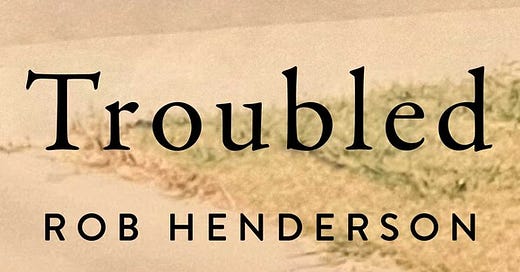Growing up in the one percent...of childhood instability
A review of "Troubled" by Rob Henderson
“Given the choice, I would swap my position in the top 1 percent of educational attainment to have never been in the top 1 percent of childhood instability. Much of my own life has been an unsuccessful flight from my childhood.”
— Rob Henderson
Watching and listening to interviews of Rob Henderson—the mild-mannered, well-spoken, Yale and Cambridge-educated researcher and author—you would never guess he was once an angry, violent adolescent who struggled in school. Once a teenager with behavior issues and self-destructive habits, he is now a respected Ph.D. and military veteran. Once an abandoned child overlooked by the adults in his life, he is now sought after for his insights by prominent journalists and podcasters.
But this isn’t a feel-good story of overcoming obstacles. It’s a heartbreaking look at the devastation an unstable childhood can have and the ripple effects of that instability well into adulthood.
The title of his memoir, “Troubled,” can have multiple meanings for the reader. Henderson had a troubled childhood and the institutions of his youth—the foster care system, the families that were entrusted with his care—were all beset by numerous problems.
But as a reader, it’s hard to finish this book and not walk away troubled as well. This book can be hard to read, not because the writing isn’t excellent, but because the life experiences Henderson describes are so gut-wrenching.
Broken Homes
If Henderson’s life were a movie, you would likely feel like the screenwriter had written too much hardship for the main character. One of Henderson’s earliest memories is clinging to his birth mother as a three-year-old while staring up at the faces of police officers who have come to arrest his mother. She was both a dealer and a user of drugs and was deported back to South Korea. He never saw her again. His birth father is not someone he ever met.
He is shuttled from foster home to foster home—some better than others. One foster parent takes him in because she likes to have a boy who can do manual labor around the house. When he nearly drowns in the pool, she watches him with cold indifference. He is finally adopted by a loving family, but the parents soon divorce and the father cuts ties with him to get revenge on his adopted mother. His mother’s next relationship—one of the more stable in Henderson’s life—becomes strained after her partner suffers a series of debilitating injuries and they both experience financial setbacks.
As someone who was blessed to grow up in a stable, loving, two-parent home, the home life Henderson describes was foreign to me. But he writes in such a way that you can still connect as a reader. Since I’m about the same age as Henderson, we share some cultural memories like Doug cartoons, Pokémon and Bill Nye the Science Guy.
He also describes an activity called “the choking game” that I distinctly remember my friends (not me) trying in our early teen years, showing that male teenage stupidity truly transcends race, class and geography. You essentially get choked and experience a rush from the lack of oxygen. It’s as dumb as it sounds.
The Gap between Rich and Poor is Not Just Financial
The book is more than just a collection of painful memories, anecdotes and life experiences. The book is also full of academic research on the impacts of poverty, instability and family dysfunction on the life outcomes of children. Henderson’s personal story puts a human face on the facts and figures presented.
Those statistics are eye-opening. Henderson makes the case that family instability can have more of an impact on life outcomes than just poverty. Unlike his peers at Yale, who overwhelmingly came from stable, two-parent households, his peers growing up in poverty largely came from unstable, single-parent families. This reflects national trends: “…while 85 percent of children born to upper-class families are raised by both of their birth parents, only 30 percent of those born to working-class families are.”
While Henderson draws upon the research of others, he also offers up his own original insights. He is probably most known for his formulation of “luxury beliefs,” which are “ideas and opinions that confer status on the upper class at little cost, while often inflicting costs on the lower classes.” Examples abound, including the Defund the Police Movement, polyamory and drug decriminalization.
Henderson is not shy about what he sees as the hypocrisy of elites. As someone who grew up in foster care and unstable families, he couldn’t help notice it was the highly-educated, affluent children of two-parent families at Yale who spoke about monogamy as outdated. Of course, many of these same people were planning to get married and raise kids in a two-parent family.
Stranger in a Strange Land
Having grown up in poverty, much of the world of the upper class at Yale and other elite institutions were foreign to him. He was on campus when students erupted after a professor sent an email defending freedom of expression when it came to controversial Halloween costumes. The professor also questioned the Yale administration’s decision to get involved rather than let students handle these disputes among themselves.
The response led to mass student protests, unrest and ultimately the professor stepping down after being hounded around campus. Students claimed the professor had caused harm and trauma (something astonishing to a military veteran watching children who grew up in prep school).
When Henderson asked a fellow student to explain this bewildering response to him, the student—who had grown up in Greenwich, Connecticut and had attended an elite prep school, Phillips Exeter Academy—told him he was too privileged to understand.






Great review of a book I couldn’t put down. Rob Henderson’s story made me cry for the boy and proud of the man. Well done!
I have this book on hold at my library and I’m so excited to read